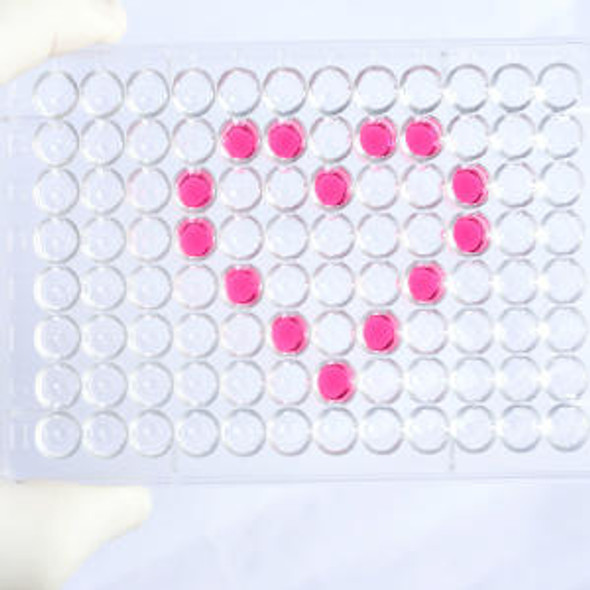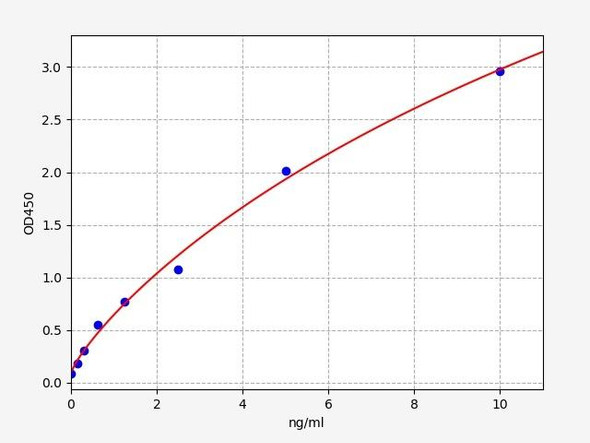Mouse Caspase-4 (Casp4) ELISA Kit (MOEB1647)
- SKU:
- MOEB1647
- Product Type:
- ELISA Kit
- Size:
- 96 Assays
- Uniprot:
- P70343
- ELISA Type:
- Sandwich
- Synonyms:
- CASP11, Caspase-4, CASP-4, Protease ICH-3
- Reactivity:
- Mouse
Description
Mouse Caspase-4 (Casp4) ELISA Kit
The Mouse Caspase-4 (CASP4) ELISA Kit is specifically designed for the precise measurement of caspase-4 levels in mouse serum, plasma, and cell culture supernatants. This kit offers exceptional sensitivity and specificity, guaranteeing accurate and consistent results, making it an excellent tool for a variety of research purposes.Caspase-4 is an important enzyme in the caspase family, playing a crucial role in inflammatory and immune responses. Its dysregulation has been implicated in various diseases such as sepsis, inflammatory bowel disease, and autoimmune disorders, highlighting its significance as a biomarker for studying these conditions and exploring potential therapeutic interventions.
With its reliable performance and ease of use, the Mouse Caspase-4 ELISA Kit is a valuable asset for researchers looking to investigate the role of caspase-4 in health and disease in mouse models.
| Product Name: | Mouse Caspase-4 (Casp4) ELISA Kit |
| SKU: | MOEB1647 |
| Size: | 96T |
| Target: | Mouse Caspase-4 (Casp4) |
| Synonyms: | Caspase-11, Protease ICH-3, CASP-11, CASP-4, Casp11, Caspl, Ich3 |
| Assay Type: | Sandwich |
| Detection Method: | ELISA |
| Reactivity: | Mouse |
| Detection Range: | 0.312-20ng/mL |
| Sensitivity: | 0.165ng/mL |
| Intra CV: | Provided with the Kit |
| Inter CV: | Provided with the Kit |
| Linearity: | Provided with the Kit |
| Recovery: | Provided with the Kit |
| Function: | Proinflammatory caspase (PubMed:8702803, PubMed:9038361, PubMed:25119034). Essential effector of NLRP3 inflammasome-dependent CASP1 activation and IL1B and IL18 secretion in response to non-canonical activators, such as UVB radiation, cholera enterotoxin subunit B and cytosolic LPS, as well as infection with Gram-negative bacteria (PubMed:22002608). Independently of NLRP3 inflammasome and CASP1, promotes pyroptosis, through GSDMD cleavage and activation, and IL1A, IL18 and HMGB1 release in response to non-canonical inflammasome activators (PubMed:22002608, PubMed:26320999, PubMed:26375003). Plays a crucial role in the restriction of Salmonella typhimurium replication in colonic epithelial cells during infection. In later stages of the infection (>3 days post infection), LPS from cytosolic Salmonella triggers CASP4 activation, which ultimately results in the pyroptosis of the infected cells and their extrusion into the gut lumen, as well as in IL18 secretion. Pyroptosis limits bacterial replication, while cytokine secretion promotes the recruitment and activation of immune cells and triggers mucosal inflammation (PubMed:25121752). Involved in LPS-induced IL6 secretion; this activity may not require caspase enzymatic activity (By similarity). Involved in cell death induced by endoplasmic reticulum stress (By similarity). Activated by direct binding to LPS without the need of an upstream sensor (PubMed:25119034). Does not directly process IL1B (PubMed:8702803, PubMed:9038361). |
| Uniprot: | P70343 |
| Sample Type: | Serum, plasma, tissue homogenates, cell culture supernates and other biological fluids |
| Specificity: | Natural and recombinant mouse Caspase-4 |
| Sub Unit: | Upon direct LPS-binding, forms large homooligomers, resulting in its activation. These oligomers are often referred to as 'non-canonical inflammasomes' (PubMed:25119034). Active as a heterotetramer consisting of two anti-parallel arranged heterodimers, each one formed by a small and a large subunit (By similarity). In its precursor form, interacts with TMEM214; this interaction is required for association with the endoplasmic reticulum membrane. Interacts with CASP1. Interacts with NOD2. |
| Research Area: | Cancer |
| Subcellular Location: | Cytoplasm Cytosol Cytoplasm Endoplasmic reticulum membrane Peripheral membrane protein Cytoplasmic side Mitochondrion Inflammasome Secreted Predominantly localizes to the endoplasmic reticulum (ER). Association with the ER membrane requires TMEM214. Released in the extracellular milieu by keratinocytes following UVB irradiation. |
| Storage: | Please see kit components below for exact storage details |
| Note: | For research use only |
| UniProt Protein Function: | CASP4: Involved in the activation cascade of caspases responsible for apoptosis execution. Cleaves caspase-1. Heterotetramer that consists of two anti-parallel arranged heterodimers, each one formed by a small and a large subunit. Widely expressed, with highest levels in spleen and lung. Moderate expression in heart and liver, low expression in skeletal muscle, kidney and testis. Not found in the brain. Belongs to the peptidase C14A family. 2 isoforms of the human protein are produced by alternative splicing. |
| UniProt Protein Details: | Protein type:EC 3.4.22.64; Apoptosis; Protease Cellular Component: cell soma; endoplasmic reticulum; membrane; mitochondrion; neuron projection; protein complex Molecular Function:cysteine-type endopeptidase activity; cysteine-type peptidase activity; hydrolase activity; peptidase activity Biological Process: actin filament organization; apoptosis; germ cell programmed cell death; positive regulation of interleukin-1 beta secretion; proteolysis; regulation of apoptosis; regulation of inflammatory response |
| NCBI Summary: | This gene encodes a member of the cysteine proteases that plays important roles in apoptosis, cell migration and the inflammatory response. The encoded protein mediates production of pro-inflammatory cytokines by macrophages upon bacterial infection. Mice lacking the encoded protein are resistant to endotoxic shock induced by lipopolysaccharide. A 5-bp deletion encompassing a splice acceptor junction resulting in alternate splicing and a shorter non-functional isoform in certain mouse strains has been described. Although its official nomenclature is "caspase 4, apoptosis-related cysteine peptidase", this gene and its encoded protein have historically been called caspase 11. This gene is present in a cluster of three caspase genes on chromosome 9. [provided by RefSeq, Apr 2015] |
| UniProt Code: | P70343 |
| NCBI GenInfo Identifier: | 341940314 |
| NCBI Gene ID: | 12363 |
| NCBI Accession: | P70343.2 |
| UniProt Secondary Accession: | P70343,O08735, Q3TAF3, |
| UniProt Related Accession: | P70343 |
| Molecular Weight: | 42,742 Da |
| NCBI Full Name: | Caspase-4 |
| NCBI Synonym Full Names: | caspase 4, apoptosis-related cysteine peptidase |
| NCBI Official Symbol: | Casp4 |
| NCBI Official Synonym Symbols: | Caspl; ich-3; CASP-4; Casp11; CASP-11 |
| NCBI Protein Information: | caspase-4 |
| UniProt Protein Name: | Caspase-4 |
| UniProt Synonym Protein Names: | Caspase-11; CASP-11 |
| Protein Family: | Caspase |
| UniProt Gene Name: | Casp4 |
| UniProt Entry Name: | CASP4_MOUSE |
| Component | Quantity (96 Assays) | Storage |
| ELISA Microplate (Dismountable) | 8×12 strips | -20°C |
| Lyophilized Standard | 2 | -20°C |
| Sample Diluent | 20ml | -20°C |
| Assay Diluent A | 10mL | -20°C |
| Assay Diluent B | 10mL | -20°C |
| Detection Reagent A | 120µL | -20°C |
| Detection Reagent B | 120µL | -20°C |
| Wash Buffer | 30mL | 4°C |
| Substrate | 10mL | 4°C |
| Stop Solution | 10mL | 4°C |
| Plate Sealer | 5 | - |
Other materials and equipment required:
- Microplate reader with 450 nm wavelength filter
- Multichannel Pipette, Pipette, microcentrifuge tubes and disposable pipette tips
- Incubator
- Deionized or distilled water
- Absorbent paper
- Buffer resevoir
*Note: The below protocol is a sample protocol. Protocols are specific to each batch/lot. For the correct instructions please follow the protocol included in your kit.
Allow all reagents to reach room temperature (Please do not dissolve the reagents at 37°C directly). All the reagents should be mixed thoroughly by gently swirling before pipetting. Avoid foaming. Keep appropriate numbers of strips for 1 experiment and remove extra strips from microtiter plate. Removed strips should be resealed and stored at -20°C until the kits expiry date. Prepare all reagents, working standards and samples as directed in the previous sections. Please predict the concentration before assaying. If values for these are not within the range of the standard curve, users must determine the optimal sample dilutions for their experiments. We recommend running all samples in duplicate.
| Step | |
| 1. | Add Sample: Add 100µL of Standard, Blank, or Sample per well. The blank well is added with Sample diluent. Solutions are added to the bottom of micro ELISA plate well, avoid inside wall touching and foaming as possible. Mix it gently. Cover the plate with sealer we provided. Incubate for 120 minutes at 37°C. |
| 2. | Remove the liquid from each well, don't wash. Add 100µL of Detection Reagent A working solution to each well. Cover with the Plate sealer. Gently tap the plate to ensure thorough mixing. Incubate for 1 hour at 37°C. Note: if Detection Reagent A appears cloudy warm to room temperature until solution is uniform. |
| 3. | Aspirate each well and wash, repeating the process three times. Wash by filling each well with Wash Buffer (approximately 400µL) (a squirt bottle, multi-channel pipette,manifold dispenser or automated washer are needed). Complete removal of liquid at each step is essential. After the last wash, completely remove remaining Wash Buffer by aspirating or decanting. Invert the plate and pat it against thick clean absorbent paper. |
| 4. | Add 100µL of Detection Reagent B working solution to each well. Cover with the Plate sealer. Incubate for 60 minutes at 37°C. |
| 5. | Repeat the wash process for five times as conducted in step 3. |
| 6. | Add 90µL of Substrate Solution to each well. Cover with a new Plate sealer and incubate for 10-20 minutes at 37°C. Protect the plate from light. The reaction time can be shortened or extended according to the actual color change, but this should not exceed more than 30 minutes. When apparent gradient appears in standard wells, user should terminatethe reaction. |
| 7. | Add 50µL of Stop Solution to each well. If color change does not appear uniform, gently tap the plate to ensure thorough mixing. |
| 8. | Determine the optical density (OD value) of each well at once, using a micro-plate reader set to 450 nm. User should open the micro-plate reader in advance, preheat the instrument, and set the testing parameters. |
| 9. | After experiment, store all reagents according to the specified storage temperature respectively until their expiry. |
When carrying out an ELISA assay it is important to prepare your samples in order to achieve the best possible results. Below we have a list of procedures for the preparation of samples for different sample types.
| Sample Type | Protocol |
| Serum | If using serum separator tubes, allow samples to clot for 30 minutes at room temperature. Centrifuge for 10 minutes at 1,000x g. Collect the serum fraction and assay promptly or aliquot and store the samples at -80°C. Avoid multiple freeze-thaw cycles. If serum separator tubes are not being used, allow samples to clot overnight at 2-8°C. Centrifuge for 10 minutes at 1,000x g. Remove serum and assay promptly or aliquot and store the samples at -80°C. Avoid multiple freeze-thaw cycles. |
| Plasma | Collect plasma using EDTA or heparin as an anticoagulant. Centrifuge samples at 4°C for 15 mins at 1000 × g within 30 mins of collection. Collect the plasma fraction and assay promptly or aliquot and store the samples at -80°C. Avoid multiple freeze-thaw cycles. Note: Over haemolysed samples are not suitable for use with this kit. |
| Urine & Cerebrospinal Fluid | Collect the urine (mid-stream) in a sterile container, centrifuge for 20 mins at 2000-3000 rpm. Remove supernatant and assay immediately. If any precipitation is detected, repeat the centrifugation step. A similar protocol can be used for cerebrospinal fluid. |
| Cell culture supernatant | Collect the cell culture media by pipette, followed by centrifugation at 4°C for 20 mins at 1500 rpm. Collect the clear supernatant and assay immediately. |
| Cell lysates | Solubilize cells in lysis buffer and allow to sit on ice for 30 minutes. Centrifuge tubes at 14,000 x g for 5 minutes to remove insoluble material. Aliquot the supernatant into a new tube and discard the remaining whole cell extract. Quantify total protein concentration using a total protein assay. Assay immediately or aliquot and store at ≤ -20 °C. |
| Tissue homogenates | The preparation of tissue homogenates will vary depending upon tissue type. Rinse tissue with 1X PBS to remove excess blood & homogenize in 20ml of 1X PBS (including protease inhibitors) and store overnight at ≤ -20°C. Two freeze-thaw cycles are required to break the cell membranes. To further disrupt the cell membranes you can sonicate the samples. Centrifuge homogenates for 5 mins at 5000xg. Remove the supernatant and assay immediately or aliquot and store at -20°C or -80°C. |
| Tissue lysates | Rinse tissue with PBS, cut into 1-2 mm pieces, and homogenize with a tissue homogenizer in PBS. Add an equal volume of RIPA buffer containing protease inhibitors and lyse tissues at room temperature for 30 minutes with gentle agitation. Centrifuge to remove debris. Quantify total protein concentration using a total protein assay. Assay immediately or aliquot and store at ≤ -20 °C. |
| Breast Milk | Collect milk samples and centrifuge at 10,000 x g for 60 min at 4°C. Aliquot the supernatant and assay. For long term use, store samples at -80°C. Minimize freeze/thaw cycles. |







